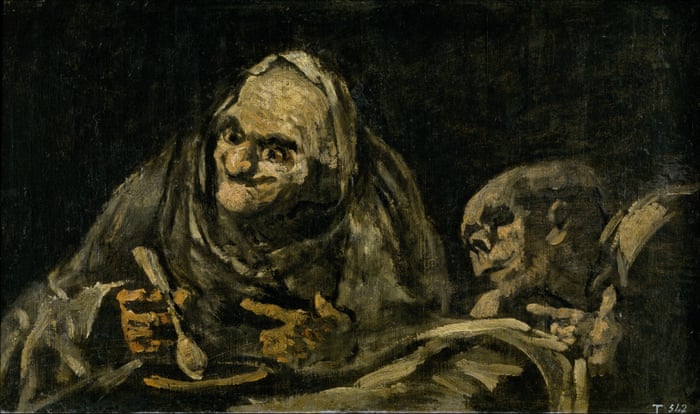
My eye is firstly drawn to the two figures. The artist has used an unknown light source on the larger figure's face, and the viewer always looks to the light first when looking at a painting, perhaps because the light is usually more comforting and safer than the darkness. But not here. Everything about Goya's black paintings signals danger, signals the Gothic and the supernatural, signals humanity's deepest fears.
The subject material is ambiguous, but it reminds me of Act Four Scene One of Shakespeare's Macbeth - the famous 'double double toil and trouble' scene. The figure of a witch on the left oddly holds a spoon, quite a modern item for someone so separate from society to be welcomed. Perhaps Goya is suggesting the repressed darkness within humanity through this spoon. Even through a simple utensil, the mind races to try and work out what Goya was thinking while he painted this directly onto one of the walls in his house. Beside the woman is a skeletal creature, perhaps death itself, although it has a rather human expression and human hand gestures. Again, Goya could be hinting at the dark side of humanity. Or perhaps hinting at the darkness consuming himself as he painted this on the wall of his own house.
Both the witch and the skeleton are looking into the unknown, the skeleton even craning its neck to see what the woman is seeing. The viewer does not know what this is, and the figure's expression is hard to read - are they smiling with glee? Through the limited colour palette, quick and imperfect brushstrokes and surrounding darkness, Goya has painted a picture breaks all the boundaries. It has the palette of realism, or seventeenth century Spanish images of saints and peasants. It has the imprecision of a half remembered nightmare dredged up from the back of his mind in the morning after a restless night. It is brutally, angrily painted and yet the relationship depicted is tender and intimate. The Black Paintings might show Goya's own descent from respected court painter to fighting his inner demons but ultimately the viewer is left to wonder yet again what is really behind the darkness. They are left to contemplate their inner fears and their own demons.
Comments
Post a Comment